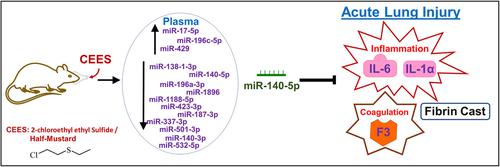当前位置:
X-MOL 学术
›
Ann. N. Y. Acad. Sci.
›
论文详情
Our official English website, www.x-mol.net, welcomes your feedback! (Note: you will need to create a separate account there.)
MicroRNA-mediated inflammation and coagulation effects in rats exposed to an inhaled analog of sulfur mustard
Annals of the New York Academy of Sciences ( IF 5.2 ) Pub Date : 2020-06-29 , DOI: 10.1111/nyas.14416 Tapasi Rana 1 , Aamir Ahmad 1 , Iram Zafar 1 , Nithya Mariappan 1 , Darshan Shimoga Chandrashekar 2 , Tariq Hamid 3 , Maroof Husain 1 , Sooryanarayana Varambally 2 , Shama Ahmad 1 , Aftab Ahmad 1
Annals of the New York Academy of Sciences ( IF 5.2 ) Pub Date : 2020-06-29 , DOI: 10.1111/nyas.14416 Tapasi Rana 1 , Aamir Ahmad 1 , Iram Zafar 1 , Nithya Mariappan 1 , Darshan Shimoga Chandrashekar 2 , Tariq Hamid 3 , Maroof Husain 1 , Sooryanarayana Varambally 2 , Shama Ahmad 1 , Aftab Ahmad 1
Affiliation

|
Exposure of rats to 2‐chloroethyl ethyl sulfide (CEES), an analog of sulfur mustard, can cause acute lung injury (ALI), resulting in increased inflammation and coagulation and altered levels of plasma microRNAs (miRNAs). Rats were exposed to aerosolized CEES and euthanized 12 h later for collection of tissue and plasma. Profiling of miRNAs in plasma, using a TaqMan‐based RT‐PCR array, revealed 14 differentially expressed miRNAs. Target gene prediction and pathway analysis revealed miRNA‐mediated regulation of organismal injury, inflammation, and respiratory diseases. miR‐140‐5p, a marker of ALI, was downregulated in the plasma, lung, liver, and kidney of CEES‐exposed rats, with a concomitant increase in the expression of the inflammation markers IL‐6 and IL‐1α and the coagulation marker tissue factor (F3). Exposure of rat airway epithelial cells (RL‐65) to CEES (0.5 mM) caused cell death and a decrease in miR‐140‐5p both in cells and media supernatant. This was accompanied by an increase in cellular mRNA levels of IL‐6, IL‐1α, and F3, as well as FGF9 and EGR2, putative targets of miR‐140. Knockdown of miR‐140 by specific oligos in RL‐65 cells mimicked the in vivo CEES‐mediated effects, leading to significantly increased mRNA levels of IL‐6, IL‐1α, F3, FGF9, and EGR2. Our study identifies miR‐140‐5p as a mediator of CEES‐induced ALI, which could potentially be targeted for therapy.
中文翻译:

MicroRNA 介导的炎症和凝血作用对大鼠吸入硫芥类似物的影响
大鼠暴露于 2-氯乙基乙基硫醚 (CEES) 是一种硫芥的类似物,可导致急性肺损伤 (ALI),导致炎症和凝血增加,并改变血浆 microRNA (miRNA) 的水平。大鼠暴露于雾化 CEES 并在 12 小时后安乐死以收集组织和血浆。使用基于 TaqMan 的 RT-PCR 阵列对血浆中的 miRNA 进行分析,揭示了 14 种差异表达的 miRNA。靶基因预测和通路分析揭示了 miRNA 介导的机体损伤、炎症和呼吸系统疾病的调节。miR-140-5p 是 ALI 的标志物,在 CEES 暴露大鼠的血浆、肺、肝和肾中下调,伴随炎症标志物 IL-6 和 IL-1α 的表达以及凝血标记组织因子 (F3)。大鼠气道上皮细胞 (RL-65) 暴露于 CEES (0.5 mM) 导致细胞死亡和细胞和培养基上清液中 miR-140-5p 的降低。这伴随着 IL-6、IL-1α 和 F3 以及 FGF9 和 EGR2(miR-140 的假定靶标)的细胞 mRNA 水平的增加。RL-65 细胞中特定寡核苷酸对 miR-140 的抑制模拟了体内 CEES 介导的作用,导致 IL-6、IL-1α、F3、FGF9 和 EGR2 的 mRNA 水平显着增加。我们的研究将 miR-140-5p 鉴定为 CEES 诱导的 ALI 的介质,可能成为治疗的目标。RL-65 细胞中特定寡核苷酸对 miR-140 的抑制模拟了体内 CEES 介导的作用,导致 IL-6、IL-1α、F3、FGF9 和 EGR2 的 mRNA 水平显着增加。我们的研究将 miR-140-5p 鉴定为 CEES 诱导的 ALI 的介质,可能成为治疗的目标。RL-65 细胞中特定寡核苷酸对 miR-140 的抑制模拟了体内 CEES 介导的作用,导致 IL-6、IL-1α、F3、FGF9 和 EGR2 的 mRNA 水平显着增加。我们的研究将 miR-140-5p 鉴定为 CEES 诱导的 ALI 的介质,可能成为治疗的目标。
更新日期:2020-06-29
中文翻译:

MicroRNA 介导的炎症和凝血作用对大鼠吸入硫芥类似物的影响
大鼠暴露于 2-氯乙基乙基硫醚 (CEES) 是一种硫芥的类似物,可导致急性肺损伤 (ALI),导致炎症和凝血增加,并改变血浆 microRNA (miRNA) 的水平。大鼠暴露于雾化 CEES 并在 12 小时后安乐死以收集组织和血浆。使用基于 TaqMan 的 RT-PCR 阵列对血浆中的 miRNA 进行分析,揭示了 14 种差异表达的 miRNA。靶基因预测和通路分析揭示了 miRNA 介导的机体损伤、炎症和呼吸系统疾病的调节。miR-140-5p 是 ALI 的标志物,在 CEES 暴露大鼠的血浆、肺、肝和肾中下调,伴随炎症标志物 IL-6 和 IL-1α 的表达以及凝血标记组织因子 (F3)。大鼠气道上皮细胞 (RL-65) 暴露于 CEES (0.5 mM) 导致细胞死亡和细胞和培养基上清液中 miR-140-5p 的降低。这伴随着 IL-6、IL-1α 和 F3 以及 FGF9 和 EGR2(miR-140 的假定靶标)的细胞 mRNA 水平的增加。RL-65 细胞中特定寡核苷酸对 miR-140 的抑制模拟了体内 CEES 介导的作用,导致 IL-6、IL-1α、F3、FGF9 和 EGR2 的 mRNA 水平显着增加。我们的研究将 miR-140-5p 鉴定为 CEES 诱导的 ALI 的介质,可能成为治疗的目标。RL-65 细胞中特定寡核苷酸对 miR-140 的抑制模拟了体内 CEES 介导的作用,导致 IL-6、IL-1α、F3、FGF9 和 EGR2 的 mRNA 水平显着增加。我们的研究将 miR-140-5p 鉴定为 CEES 诱导的 ALI 的介质,可能成为治疗的目标。RL-65 细胞中特定寡核苷酸对 miR-140 的抑制模拟了体内 CEES 介导的作用,导致 IL-6、IL-1α、F3、FGF9 和 EGR2 的 mRNA 水平显着增加。我们的研究将 miR-140-5p 鉴定为 CEES 诱导的 ALI 的介质,可能成为治疗的目标。



























 京公网安备 11010802027423号
京公网安备 11010802027423号